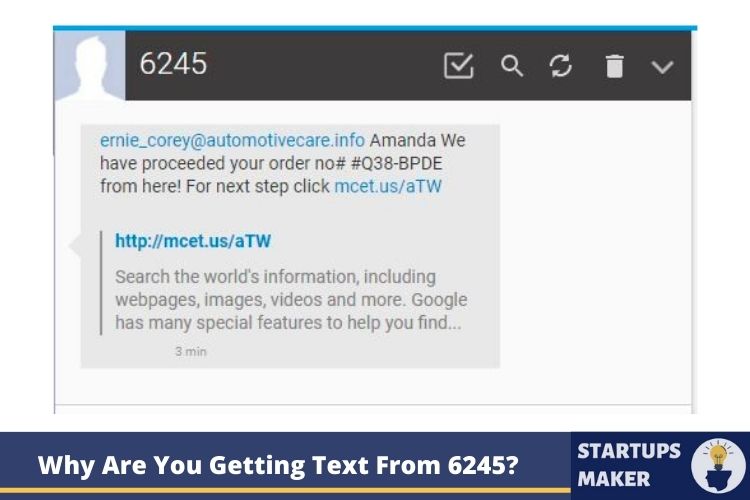In recent times, a surge of curiosity and concern has arisen among Verizon users receiving text from 6245 number. These cryptic messages, originating from an unfamiliar source, have left many puzzled and anxious. In this article, we delve into the intricacies of the 6245 text message phenomenon, shedding light on its origin, purpose, and how users can manage this communication channel.
Unmasking the 6245 text message

Verizon is a large telecommunications company based in the United States. It provides a wide range of services including wireless communication, broadband internet, and landline telephone services. Verizon is one of the major players in the telecommunications industry and serves millions of customers across the country. They offer a variety of plans and services tailored to individual, family, and business needs.
The enigmatic 6245 text is not the work of scammers, but rather a legitimate communication protocol owned by Verizon. This four-digit code represents a short code, a specialized number allocated for high-throughput and two-way messaging. Its primary function is to facilitate the exchange of Short Message Service (SMS) and Multimedia Messaging Service (MMS) between mobile devices. Initially misconstrued as a potential scam, it is, in fact, a tool employed by Verizon for their mail service.
The Role of 6245 Short Code
Verizon users can leverage the 6245 text to seamlessly send emails via their phones. This innovation bridges the gap for individuals who lack email addresses but possess phone numbers for direct communication. The deployment of short codes, such as 6245, enables companies to reach a wider audience, transcending the limitations of a standard phone number. Information regarding short code owners can be accessed through the US Short Code Directory.
Why are you Receiving 6245 Text?
The source of a text from 6245 message is the Verizon network itself. This service empowers Verizon users to employ the recipient’s phone number as a conduit for sending both emails and text messages. It is a pivotal feature of Verizon’s communication infrastructure.
Verizon sends messages from 6245 text code as part of their service offerings. This short code facilitates the exchange of Short Message Service (SMS) and Multimedia Messaging Service (MMS) between mobile devices. It is primarily used for high-throughput and two-way messaging, allowing Verizon users to send emails and texts using the recipient’s phone number.
The purpose of this service is to provide a convenient and user-friendly way for Verizon customers to communicate, particularly for those who may not have email addresses but have phone numbers. It allows for seamless communication between individuals, families, and businesses, bridging the gap between different forms of contact information.
While this service is generally legitimate and useful, users should exercise caution and be aware that any individual with access to their Verizon phone number can send messages via this short code. This openness can potentially lead to the receipt of unsolicited or unwanted messages, which is why it’s important for users to be cautious and take steps to manage their messaging preferences.
Distinguishing Legitimate Messages from Scams
While 6245 text code provides a convenient channel for legitimate communication, it is imperative to exercise caution. Any individual possessing your Verizon phone number can dispatch messages via this short code. This opens the door not only to well-intentioned messages but also to potential spam, scams, and unsolicited contacts. It is strongly advised to refrain from responding to messages from unknown or unrecognized numbers to safeguard personal information.
Mitigating Unwanted 6245 Text Messages
Given the potential for intrusive, offensive, or inappropriate content, some users seek to limit their exposure to text from 6245 messages. An effective strategy involves removing and re-adding signed-in email accounts within the Email app.
To exercise control over incoming messages from 6245 shot code, users can employ several technical methods:
Blocking command (Text “block 6245” to 9999):
This directive acts as a preventative measure, halting further messages from the 6245 short code. It utilizes Verizon’s network controls to restrict incoming communications.
Email account management:
Users can opt to remove and subsequently re-add signed-in email accounts within the Email app. This process serves as a tactical approach to regain control over message inflow.
“STOP” Command (Text “STOP” to 6245):
This command, initiated by the recipient, is an additional deterrent against unwanted messages. It triggers Verizon’s system to recognize and respect the user’s preference to cease communication from the 6245 short code.
These technical measures serve to empower users in customizing their messaging experience, ensuring a more secure and tailored communication environment.
Regulatory Compliance and User Privacy
It’s important to note that the use of short codes like 6245 is regulated by various telecommunications authorities to ensure responsible usage. Verizon, as a reputable telecommunications company, adheres to these regulations, prioritizing user privacy and security. They have measures in place to safeguard personal information and ensure that their messaging services are used in compliance with legal and regulatory standards.
Also Read: What is JPMC Re Paypal Intl Ltd? Detailed Guide
Conclusion
The text from 6245 or 6245 text message phenomenon has sparked curiosity and concern among Verizon users. However, this enigmatic communication channel is not a scam, but rather a legitimate protocol owned by Verizon. It operates through a specialized short code, facilitating high-throughput and two-way messaging for SMS and MMS exchanges between mobile devices. This innovation provides a bridge for those without email addresses, enabling seamless communication through phone numbers.
While 6245 offers a convenient channel for legitimate communication, users must exercise caution, as it opens the door to potential spam and unsolicited messages. Implementing technical measures such as blocking commands, email account management, and the “STOP” command empowers users to customize their messaging experience and ensure a more secure and tailored communication environment. Understanding the intricacies of the 6245 text code phenomenon allows users to navigate this communication channel with confidence and control.
